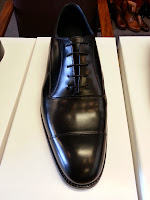The last few styles of Gieves & Hawkes' fabulous (if we say so ourselves), new, ready to wear shoe collection came in this week.
So, we have been busy giving the shop floor team a refresher in fitting and selling shoes. I'm not sure retailers usually bother with this - kids' shoe shops seem to be the only ones where any kind of fitting is done - but to sell men's shoes well, you need to know what you are talking about especially when it comes to fit.
This advertising slogan from the 1930s says it all.
This slogan is taken from a volume of F.Y.Golding's books "Boots & Shoes their Making, Manufacture and Selling". Comparing our fitting notes with theirs, not much has changed in 100 years. The x-rays of feet in shoes below are a great illustration of what to and what NOT to look for!
1. Room for the toes - shoes will not stretch lengthwise so if the toes touch, the shoes are too small!
 |
| Above top: the shoe is too cramped for the toes Above bottom: the shoe fits well with adequate space for the toes |
 |
| Here the heel to joint fit is incorrect - the shoe is too big for the foot - the heel and big toe joint are too far forward - the toes are scrunched up to hold the shoe on. |
 |
| Here the heel to ball fit is good: - the heel sits back into the shoe - the ball of the foot is correctly positioned - the toes are relaxed. |
 |
| Here, the salesman allows the customer to slip his foot into the shoe; the angle of the foot rest encourages the foot to naturally sit back into the heel of the shoe. |
In Gieves' ready-to-wear shoes, the last has a deep, slightly elongated toe box to offer more toe space for different foot shapes and cushioned socks for an immediate feeling of comfort and support. (The cushioning takes up space in the shoe so a little extra room has been added to the lasts to allow for it).
Shoe fitting tips:
- Know your shoe styles
- Know feet and get used to handling them (!)
- Never discuss size (we know what a sensitive subject it can be!!!)
- Initially try a bigger size, so the first experience is of space not pain
- Ask the customer to remove both of their shoes before trying on the new pair. Having one old shoe and one new shoe on is an unfair comparison. An old pair of shoes naturally feels more comfortable than new shoes.
- Let the customer slip their foot into the shoe, do not put the shoe on the foot - encourage them to use a shoehorn to put the shoes on (fingers will stretch the shoes at the back)
- Allow the customer to make the choice as far as possible, with guidance
- Do not sell a pair of shoes that do not fit - it is a false economy
- Offer an alternative style of shoe, if the first style choice does not work for the customer's feet.
A high instep will benefit from a Derby or Monk strap shoe rather than an Oxford, as will a foot that swells during the day; a wide foot will work better in a Derby, Loafer or suede shoe; a narrow foot and heel will work better in an Oxford; a wide foot will benefit from a suede shoe or one without a wing cap or seams across the vamp
It is often hard for the customer to articulate what feels wrong or right. These pictures show a lady and a salesman using a Pedoscope. This contraption allowed the customer to see how their feet looked in a pair of shoes and took x-rays of them, like the ones shown. What a brilliant idea! But where have all of the Pedoscopes gone? Has anyone seen one or better yet tried a Pedoscope?
Until we get our hands on one, the team at Gieves will just have to rely on good, old-fashioned know-how!
Until next week, happy shoemaking!







